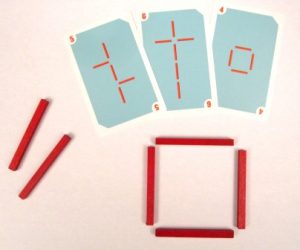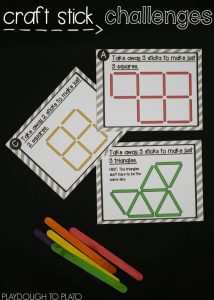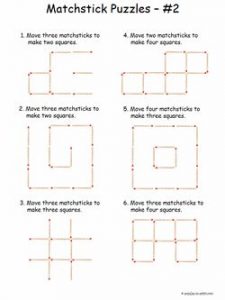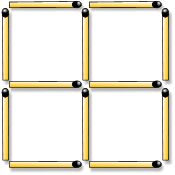
With a simple box of match sticks or toothpicks you can develop this entertaining game to improve your perception/gnosis and attention. Match sticks or toothpicks should not be broken or overlapped. Game cards can be made manually according to the original model also other variants can be added ( according to the player’s or assistants imagination and creativity) The player should reproduce with sticks the figures on the cards following the game rule.
Basic information
Definition:
SixStix is a card game in which all of the cards are laid face down on a surface and the player should reproduce with sticks the figures on the cards following the game rule.
Objectives
The object of the game is to collect as many cards as possible by rearranging the sticks to match the patterns on the cards. The player with the most cards at the end wins the game.
This game can be very good to improve the following cognitive dimensions:
Duration
Duration depends on the difficulty, usually is about 30 minutes.
Cost:
- ICT version: no
- Physical version: 17,50€
References:
- Background material: download this pdf:
Development
Participants
Participants’ profile:
- Dementia level: game can be adjusted to match mild to moderate dementia levels.
- Physical requirements:
- Not high in general. For highly limited users, the game can be played using an assistant that follows the user’s instructions.
- For physical card games: good functionality at arms and hands (it will be more or less exigent depending on the card’s shape)
Number of participants:
- This game can be played with 1-4 players or as solitaire.
Material and requirements
- Materials needed to develop the game: 55 cards, 6 wooden sticks, 1 game rules.
- With a simple box of match sticks or toothpicks you can develop this game. Game cards can be made manually according to the original model also other variants can be added (according to the player’s or assistants imagination and creativity).
- Environment considerations: Good lighting levels. Avoid glare.
Support needed
Professionals / relatives can:
- Explain the game instructions
- Supervise the correct development of the game.
- Help with the counting / score
In some cases (for highly physically limited users), they can turn the cards following the user’s instructions.
Starting point:
- Physical game: prepare the cards, faced down, on a table or horizontal surface.
Development:
(Important: these are general instructions for a pair game. The game admits several variations and alternatives)
There are commercial sets of cards with images. The rules given here are for a standard deck of 55 cards, which are normally laid face down.
Shuffle the cards and place them face down. Lay out 5 sticks end-to –end and keep the remaining stick next to the pile of the cards. Distribute 4 cards to each player. The cards are laid out, face visible, in front of each player. The players can turn the cards in any direction and they can change the order of the cards. The player who most recently has lighted a match starts the game and the others follow in turns clockwise. Now the player has to match the figures on the cards by taking 2 turns. Adding, removing or moving the sticks counts as 1 turn.
Turning the sticks while maintaining contact with the other sticks with one end of the stick is considered a free move, i.e. it does not count as a turn.
Note: any move cannot split the patter in two.
Each time the player manages to match a pattern, he/she gets to keep that card. Cards that you are not able to take are kept until the next round. Replenish up to 4 cards from the deck before passing your turn. If you manage to match all 4 cards, you get to take one extra card from the pile as a bonus.
The game ends when the all cards have been used, the player with the most cards wins the game.
See an example:
Additional information
Variants of the game:
- Point system: change the point system by counting the points that are inscribed on each card. That will make for lots of photo-finish races.
- Solitaire mode: challenge yourself by playing SixStix as a solitaire game. Take 40 cards and set the other cards aside. Lay out 5 sticks end-to-end and keep the remaining stick next to the pile of cards. You now have 10 turns to get through the 40 cards following the same rules as the original game (i.e. 4 cards per turn, 2 moves per turn) with one exception. After each round you keep the cards you won and discard the cards you weren’t able to match.
Alternative games:
Other related games:
- Match sticks puzzles: http://matchstickpuzzles.blogspot.ro/
http://www.learning-tree.org.uk/stickpuzzles/stick_puzzles.htm
Example video:
Assessment:
- Time needed to perform the game
- Number of mistakes
- Help needed
Practical activity
![]()








